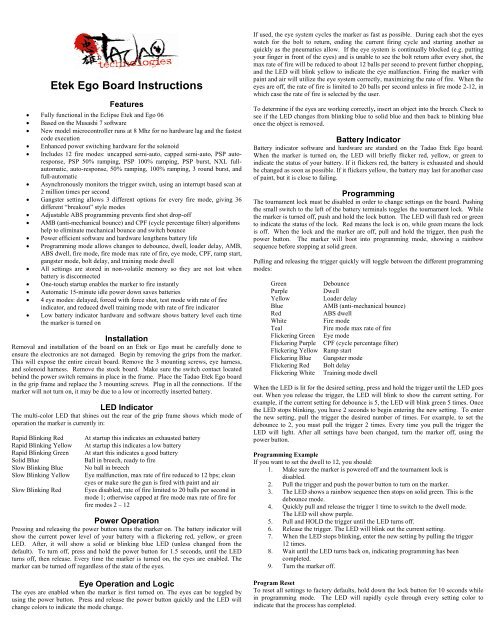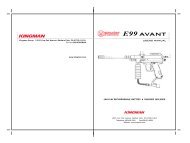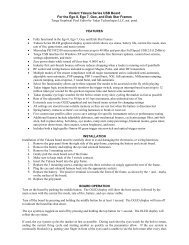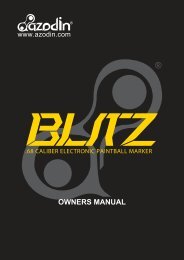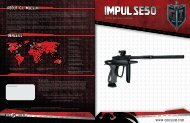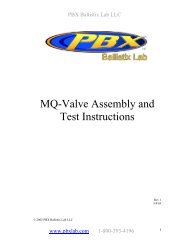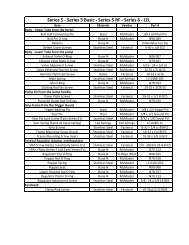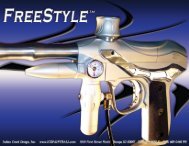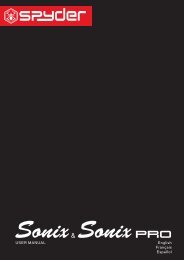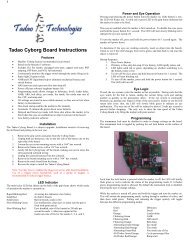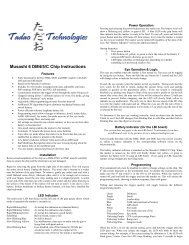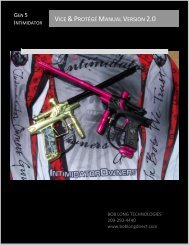Etek Ego Board Instructions - Tadao Technologies
Etek Ego Board Instructions - Tadao Technologies
Etek Ego Board Instructions - Tadao Technologies
Create successful ePaper yourself
Turn your PDF publications into a flip-book with our unique Google optimized e-Paper software.
<strong>Etek</strong> <strong>Ego</strong> <strong>Board</strong> <strong>Instructions</strong>Features• Fully functional in the Eclipse <strong>Etek</strong> and <strong>Ego</strong> 06• Based on the Musashi 7 software• New model microcontroller runs at 8 Mhz for no hardware lag and the fastestcode execution• Enhanced power switching hardware for the solenoid• Includes 12 fire modes: uncapped semi-auto, capped semi-auto, PSP autoresponse,PSP 50% ramping, PSP 100% ramping, PSP burst, NXL fullautomatic,auto-response, 50% ramping, 100% ramping, 3 round burst, andfull-automatic• Asynchronously monitors the trigger switch, using an interrupt based scan at2 million times per second• Gangster setting allows 3 different options for every fire mode, giving 36different “breakout” style modes• Adjustable ABS programming prevents first shot drop-off• AMB (anti-mechanical bounce) and CPF (cycle percentage filter) algorithmshelp to eliminate mechanical bounce and switch bounce• Power efficient software and hardware lengthens battery life• Programming mode allows changes to debounce, dwell, loader delay, AMB,ABS dwell, fire mode, fire mode max rate of fire, eye mode, CPF, ramp start,gangster mode, bolt delay, and training mode dwell• All settings are stored in non-volatile memory so they are not lost whenbattery is disconnected• One-touch startup enables the marker to fire instantly• Automatic 15-minute idle power down saves batteries• 4 eye modes: delayed, forced with force shot, test mode with rate of fireindicator, and reduced dwell training mode with rate of fire indicator• Low battery indicator hardware and software shows battery level each timethe marker is turned onInstallationRemoval and installation of the board on an <strong>Etek</strong> or <strong>Ego</strong> must be carefully done toensure the electronics are not damaged. Begin by removing the grips from the marker.This will expose the entire circuit board. Remove the 3 mounting screws, eye harness,and solenoid harness. Remove the stock board. Make sure the switch contact locatedbehind the power switch remains in place in the frame. Place the <strong>Tadao</strong> <strong>Etek</strong> <strong>Ego</strong> boardin the grip frame and replace the 3 mounting screws. Plug in all the connections. If themarker will not turn on, it may be due to a low or incorrectly inserted battery.LED IndicatorThe multi-color LED that shines out the rear of the grip frame shows which mode ofoperation the marker is currently in:Rapid Blinking RedRapid Blinking YellowRapid Blinking GreenSolid BlueSlow Blinking BlueSlow Blinking YellowSlow Blinking RedAt startup this indicates an exhausted batteryAt startup this indicates a low batteryAt start this indicates a good batteryBall in breech, ready to fireNo ball in breechEye malfunction, max rate of fire reduced to 12 bps; cleaneyes or make sure the gun is fired with paint and airEyes disabled, rate of fire limited to 20 balls per second inmode 1; otherwise capped at fire mode max rate of fire forfire modes 2 – 12Power OperationPressing and releasing the power button turns the marker on. The battery indicator willshow the current power level of your battery with a flickering red, yellow, or greenLED. After, it will show a solid or blinking blue LED (unless changed from thedefault). To turn off, press and hold the power button for 1.5 seconds, until the LEDturns off, then release. Every time the marker is turned on, the eyes are enabled. Themarker can be turned off regardless of the state of the eyes.Eye Operation and LogicThe eyes are enabled when the marker is first turned on. The eyes can be toggled byusing the power button. Press and release the power button quickly and the LED willchange colors to indicate the mode change.If used, the eye system cycles the marker as fast as possible. During each shot the eyeswatch for the bolt to return, ending the current firing cycle and starting another asquickly as the pneumatics allow. If the eye system is continually blocked (e.g. puttingyour finger in front of the eyes) and is unable to see the bolt return after every shot, themax rate of fire will be reduced to about 12 balls per second to prevent further chopping,and the LED will blink yellow to indicate the eye malfunction. Firing the marker withpaint and air will utilize the eye system correctly, maximizing the rate of fire. When theeyes are off, the rate of fire is limited to 20 balls per second unless in fire mode 2-12, inwhich case the rate of fire is selected by the user.To determine if the eyes are working correctly, insert an object into the breech. Check tosee if the LED changes from blinking blue to solid blue and then back to blinking blueonce the object is removed.Battery IndicatorBattery indicator software and hardware are standard on the <strong>Tadao</strong> <strong>Etek</strong> <strong>Ego</strong> board.When the marker is turned on, the LED will briefly flicker red, yellow, or green toindicate the status of your battery. If it flickers red, the battery is exhausted and shouldbe changed as soon as possible. If it flickers yellow, the battery may last for another caseof paint, but it is close to failing.ProgrammingThe tournament lock must be disabled in order to change settings on the board. Pushingthe small switch to the left of the battery terminals toggles the tournament lock. Whilethe marker is turned off, push and hold the lock button. The LED will flash red or greento indicate the status of the lock. Red means the lock is on, while green means the lockis off. When the lock and the marker are off, pull and hold the trigger, then push thepower button. The marker will boot into programming mode, showing a rainbowsequence before stopping at solid green.Pulling and releasing the trigger quickly will toggle between the different programmingmodes:GreenDebouncePurpleDwellYellowLoader delayBlueAMB (anti-mechanical bounce)RedABS dwellWhiteFire modeTealFire mode max rate of fireFlickering Green Eye modeFlickering Purple CPF (cycle percentage filter)Flickering Yellow Ramp startFlickering Blue Gangster modeFlickering Red Bolt delayFlickering White Training mode dwellWhen the LED is lit for the desired setting, press and hold the trigger until the LED goesout. When you release the trigger, the LED will blink to show the current setting. Forexample, if the current setting for debounce is 5, the LED will blink green 5 times. Oncethe LED stops blinking, you have 2 seconds to begin entering the new setting. To enterthe new setting, pull the trigger the desired number of times. For example, to set thedebounce to 2, you must pull the trigger 2 times. Every time you pull the trigger theLED will light. After all settings have been changed, turn the marker off, using thepower button.Programming ExampleIf you want to set the dwell to 12, you should:1. Make sure the marker is powered off and the tournament lock isdisabled.2. Pull the trigger and push the power button to turn on the marker.3. The LED shows a rainbow sequence then stops on solid green. This is thedebounce mode.4. Quickly pull and release the trigger 1 time to switch to the dwell mode.The LED will show purple.5. Pull and HOLD the trigger until the LED turns off.6. Release the trigger. The LED will blink out the current setting.7. When the LED stops blinking, enter the new setting by pulling the trigger12 times.8. Wait until the LED turns back on, indicating programming has beencompleted.9. Turn the marker off.Program ResetTo reset all settings to factory defaults, hold down the lock button for 10 seconds whilein programming mode. The LED will rapidly cycle through every setting color toindicate that the process has completed.
SettingsDebounce – The <strong>Tadao</strong> <strong>Etek</strong> <strong>Ego</strong> board features an interrupt based debounce algorithmthat effectively “scans” the trigger over 2 million times per second. It runs thiscompletely independent of code execution on the microcontroller so your trigger pullsare always registered. The debounce setting is in increments of 1/2 milliseconds. Usersshould be aware that low debounce settings may cause the marker to read switch bounceas additional pulls, falsely generating shots or near full-automatic fire. The settingranges from 1 to 50 and is defaulted at 10 (5 ms).Dwell – The amount of time the solenoid is energized each time the marker is fired. Thedefault is 12 ms. The range is 2 to 20 ms. Too low of a dwell may lead to inconsistencyor drop-off. Too high of a dwell can cause bad air efficiency.Loader delay – Adds a slight delay after the eye has seen a ball and the bolt is cycled,causing the gun to fire. If not using force fed loaders, it may be necessary to increasethis setting to prevent chopping. A setting of 1 means no loader delay, which is thefastest. The default is 2 and may be set from 1 to 25.AMB (Anti-mechanical bounce) – Allows the user to adjust the anti-mechanicalbounce feature. Mechanical bounce occurs due to the kick generated during each shotand can cause the marker to “run away” on the first few shots. AMB helps stop markersfrom going full-auto when the trigger is pulled very slowly. The default is 2 and may beset from 1 to 5 (1 being off). AMB is only used in fire modes 1 and 2 (semi-automaticunlimited and adjustable).ABS dwell – Amount of dwell time added for an ABS (anti-bolt stick) shot. The rangeis from 1 to 10 additional milliseconds of dwell. The default is 1, which is disabled.ABS programming helps to eliminate first shot drop-off. First shot drop-off occurs whenthe lube and o-rings settle or “stick” inside the marker after it has been sitting. The nextshot fired will be lower in velocity because the bolt has to break free. ABS will slightlyincrease the dwell to compensate if the marker is left sitting for 15 seconds.Fire mode – Included are 12 different fire modes (default is 1):1. Semi-automatic, unlimited rate of fire2. Semi-automatic, adjustable rate of fire3. PSP auto-response4. PSP 50% ramping, adjustable ramp start5. PSP 100% ramping, adjustable ramp start6. PSP burst7. NXL full-automatic8. Auto-response9. 50% ramping10. 100% ramping11. 3 round burst12. Full-automaticSetting 1 is normal semi-automatic with an unlimited rate of fire while the eyes areenabled. When the eyes are turned off, the max rate of fire is set to 20 balls per second.Setting 2 is semi-automatic with an adjustable rate of fire. It limits the maximum ballsper second that can be fired. The cap is set by the max rate of fire setting.Setting 3 is the PSP auto-response fire mode that works as follows:• The first 3 shots of a string are semi-automatic• After the 4th shot the marker will fire on the pull and release in autoresponsemode• If the user stops firing for more than 1 second, the 3-shot semi-automaticcount starts overSetting 4 is the PSP 50% ramping fire mode that works as follows:• The first 3 shots of a string are semi-automatic• After the 4th shot the marker will ramp, adding 1 additional shot for every 2pulled by the user, as long as the user pulls the trigger faster than the rampstart setting• If the user stops firing for more than 1 second, the 3-shot semi-automaticcount starts overSetting 5 is the PSP 100% ramping fire mode that works as follows:• The first 3 shots of a string are semi-automatic• After the 4th shot the marker will ramp up to the loader’s maximum speed orthe maximum rate of fire, as long as the user pulls the trigger faster than theramp start setting• If the user stops firing for more than 1 second, the 3-shot semi-automaticcount starts overSetting 6 is the PSP burst fire mode that works as follows:• The first 3 shots of a string are semi-automatic• After the 4th shot the marker will burst fire 3 shots per pull• If the user stops firing for more than 1 second, the 3-shot semi-automaticcount starts overSetting 7 is the NXL full-automatic fire mode. It functions similarly to the PSP firemodes except, after the 3rd semi-automatic shot, the user may pull and hold the triggerfor the marker to fire in full-automatic.Setting 8 is the normal auto-response fire mode. The marker will fire on each pull andrelease of the trigger, generating 2 shots per full pull cycle.Setting 9 is the normal 50% ramping fire mode. The marker will fire in semi-automaticunless the user pulls the trigger faster than the ramp start setting. Once the ramp startsetting has been achieved, the marker will 50% ramp, adding 1 additional shot for every2 trigger pulls.Setting 10 is the normal 100% ramping fire mode. The marker will fire in semiautomaticunless the user pulls the trigger faster than the ramp start setting. Once theramp start setting has been achieved, the marker will ramp up to the maximum feed rateof the loader or the maximum rate of fire setting, whichever is lower.Setting 11 is the normal 3 round burst fire mode. The marker will burst fire 3 times forevery pull and release of the trigger.Setting 12 is the normal full-automatic fire mode. As long as the trigger is depressed themarker will fire in full-automatic.Fire mode max rate of fire – The max rate of fire setting applies to the 2nd – 12th firemodes. The max rate of fire is adjustable from 14 to 20 balls per second in 1/4 balls persecond increments, and has an unlimited setting for maxing out the loader system. Thedefault is 4, which is roughly 14.75 balls per second. Oscillator inconsistencies fromchip to chip make it impossible to time perfectly, so the only true way to check rate offire is to use a Pact Timer or ballistic chronograph. The red radar chronographscommonly found at fields are NOT reliable.Setting BPS Setting BPS Setting BPS1 14.0 9 16.0 17 18.02 14.25 10 16.25 18 18.253 14.5 11 16.5 19 18.54 14.75 12 16.75 20 18.755 15.0 13 17.0 21 19.06 15.25 14 17.25 22 19.257 15.5 15 17.5 23 19.58 15.75 16 17.75 24 19.7525 20.026 Unlimited eyes on20 bps eyes offEye Mode – Four eye modes are available:1. Delayed – If the eye system does not detect a ball in the breech for 1/2 second, themarker automatically fires. This is useful for sound activated loaders because itensures that a shot is fired, even without paint, so the loader will continue to feed.2. Forced with force shot – The marker only fires if paint is seen in the breech or theuser pulls and holds the trigger for 1/2 second, thereby initiating a force shot.3. Test – This mode is specifically for seeing how fast the user can fire the marker, orhow fast the pneumatics can actually cycle. The eyes work to prevent firing ifthey are blocked. This mode is only for dry firing. The LED is used to show thefastest achieved rate of fire:Red less than 10 bpsYellow between 10 and 15 bpsGreen between 15 and 20 bpsBlue between 20 and 25 bpsWhite 25 bps or greaterAs long as the user continues to fire, the fastest achieved rate of fire will continueto be displayed on the LED. If the user stops firing for 1 second, the LED willcycle back through the rate of fire colors.4. Training – This mode works just like the test eye mode, but features an adjustabledwell setting independent of the normal dwell, which makes it easy for users toadjust their trigger settings and try them out with much less noise and airconsumption. The training mode dwell setting corresponds with this eye mode.
Note: The test and training eye mode works with any fire mode selected. The fire modemax rate of fire is set to unlimited while in test eye mode.CPF (Cycle percentage filter) – The cycle percentage filter allows adjustment of thepoint within the current firing cycle that a new buffered shot is allowed. Almost allelectronic paintball markers allow a single shot to be buffered in the event the user isfast enough to release the trigger and pull again during the current firing cycle. TheCPF setting is adjustable from 1 to 10. Setting 1 turns the CPF off, allowing bufferedshots at any point in the firing cycle. Setting 2 through 10 sets the percentage of thefiring cycle that must pass before shots may be buffered:1. CPF turned off2. 10% of the firing cycle must pass before a buffered shot is allowed3. 20%4. 30%5. 40%6. 50%7. 60%8. 70%9. 80%10. 90%A higher CPF setting results in less unintentional bounce. For instance, it is possiblethat if your debounce setting is border line, you can fire the marker a few times, thenhold it loosely and allow it to brush against your finger, going full-automatic. Sincemost switch bounce from either a low debounce setting or mechanical bounce occursalmost immediately after the trigger is released, CPF can be very effective in eliminatingfalsely generated trigger activity.Ramp start – This setting is only used for the four ramping fire modes (PSP 50% and100% ramping, and normal 50% and 100% ramping). It sets the minimum pulls persecond that must be maintained for the software to add shots or ramp up to themaximum rate of fire setting. The default is 5 and is adjustable from 4 to 14 pulls persecond.Gangster mode – The <strong>Tadao</strong> <strong>Etek</strong> <strong>Ego</strong> board includes a special mode that can beapplied 3 different ways to each of the 12 fire modes, giving 36 “breakout” stylecombinations. Gangster mode gives the user full-automatic with an unlimited rate offire for a single pull, for use at the start of the game. The setting is defaulted at 4, whichturns gangster mode off. Settings 1, 2, and 3 dictate at which pull that gangster modewill become active. If set to 1, the first shot after you turn on the marker will be fullautomaticwith an unlimited rate of fire for as long as you hold down the trigger. Assoon as you release the trigger, the marker will stop shooting and default back to yourselected fire mode. If set to 3, the gangster mode will be active on the third shot afterthe marker is turned on. Regardless of the fire mode selected, the shots before thegangster mode will be semi-automatic. Gangster mode can only be used once for eachtime the marker is turned on.Note: The gangster mode is illegal for use in all tournament series. <strong>Tadao</strong><strong>Technologies</strong> LLC takes no responsibility for the user’s choice in using thegangster mode.Bolt delay – This setting determines how long the eyes are ignored after the dwell timeends. Some delay is necessary to allow the bolt to get far enough forward so the eyesystem does not mistake a small gap between a paintball and the bolt face for a boltreturn. The default is 10 ms and may be set from 1 to 15 ms. Higher settings will reducethe maximum capable rate of fire, while lower settings may lead to skipped or blankshots because the bolt does not have enough time to block the eyes on its forward stroke.Training mode dwell – This setting selects the markers dwell time if using the trainingeye mode (eye mode set to 4). The dwell time is reduced so that the marker barelycycles, consuming less air and emitting less noise so users can train their finger speed.This setting is adjustable from 1 to 10 ms, and is defaulted at 2 ms. If this setting is toohigh, the marker may actually fire. If that is your intention, you should switch to the testeye mode, which uses the normal dwell setting.the detents where the eyes are unable to see it. After force firing, the next ball will load,and operation will continue as normal.A tip for setting the debounce, AMB, and CPF – This only applies to semi-automaticfire modes (modes 1 and 2) since AMB is disabled in the PSP fire modes or NXL mode.Debounce, AMB, CPF setup steps, while using paint and air:1. Turn AMB and CPF off (set both to 1).2. Starting at debounce 1-3, raise the debounce setting a notch at a time untilexcessive trigger bounce goes away. The goal is to have one pull, one shot,regardless of rate of fire. Do NOT slow pull test for bounce during this phase.Instead, pull the trigger rapidly or walk it, listening for double or triple fires.3. When it appears that it is only one shot, one pull for solid trigger pulls, try theslow pull test. Holding the marker steady, slowly pull the trigger and see ifmultiple shots can be generated from the single pull.4. Increase the CPF setting a notch at a time until the slow pull bounce starts todisappear. An additional test is to fire a few rounds quickly, then hold the triggerright on the activation point to see if the marker will run away.5. If you reach setting 10 with CPF and the marker can still be slow pulled to firefull-automatic, your debounce setting is probably too low. Go back to step 2.6. AMB should not be set above 3, if possible, since it is not as transparent to theuser as CPF. Even a CPF setting of 10 will not be noticed by the user.Example Setting Profiles:1. Tournament legal semi-automatic (NPPL)a. Fire mode 1 or 2 (semi-auto unlimited or capped)b. Debounce 5-20c. AMB 2d. CPF 2-5e. Loader delay set to match your loader (1-4 for Halo, 4-10 for gravity feed)2. PSP X-Ball, CFOAa. Fire mode 3, 4, 5, or 6b. Max rate of fire set to 3-5, depending on Pact Timer readings. To be safe,use setting 3 (14.5 balls per second).c. Debounce 5-20d. Ramp start 5 or higher if using PSP 50% or 100% rampinge. Loader delay set to match your loader (1-4 for Halo, 4-10 for gravity feed)3. Millenniuma. Fire mode 4, 5, 9, or 10 (PSP or normal ramping modes)b. Max rate of fire set to 3-5, depending on Pact Timer readings. To be safe,use setting 3 (14.5 balls per second).c. Debounce 5-20d. Ramp start 8 or highere. Loader delay set to match your loader (1-4 for Halo, 4-10 for gravity feed)4. NXLa. Fire mode 7 (NXL full-automatic).b. Max rate of fire set to 3-5, depending on Pact Timer readings. To be safe,use setting 3 (14.5 balls per second).c. Debounce 5-20d. Loader delay set to match your loader (1-4 for Halo, 4-10 for gravity feed)5. Ludicrous Speed (absolute fastest/bounciest)a. Any fire modeb. Max rate of fire set to 26 (unlimited)c. Debounce 1d. AMB 1 if using semi-automatice. CPF 1f. Ramp start 4 if using any ramping modesg. Loader delayAdditional Informationwww.tadaotechnologies.comAdditional FeaturesDraxxus Pulse loader RF transmitter harness – Included with your <strong>Tadao</strong> <strong>Etek</strong> <strong>Ego</strong>board is a wiring harness that allows plug and play installation of the Draxxus Pulseloader RF transmitter. The wiring harness plugs into the 2-pin solenoid socket on theboard, which is then plugged into the solenoid wiring. A pair of leads runs off thewiring harness to another socket, which can be plugged into the RF transmitter block,powering the transmitter each time the marker is fired.Force Shot – In the event the eyes are enabled, the breech is empty, and the user wantsto fire a clearing shot, a force shot can be initiated by pulling and holding the trigger for1/2 second. This is useful with force fed loaders that sometimes push a ball slightly into


